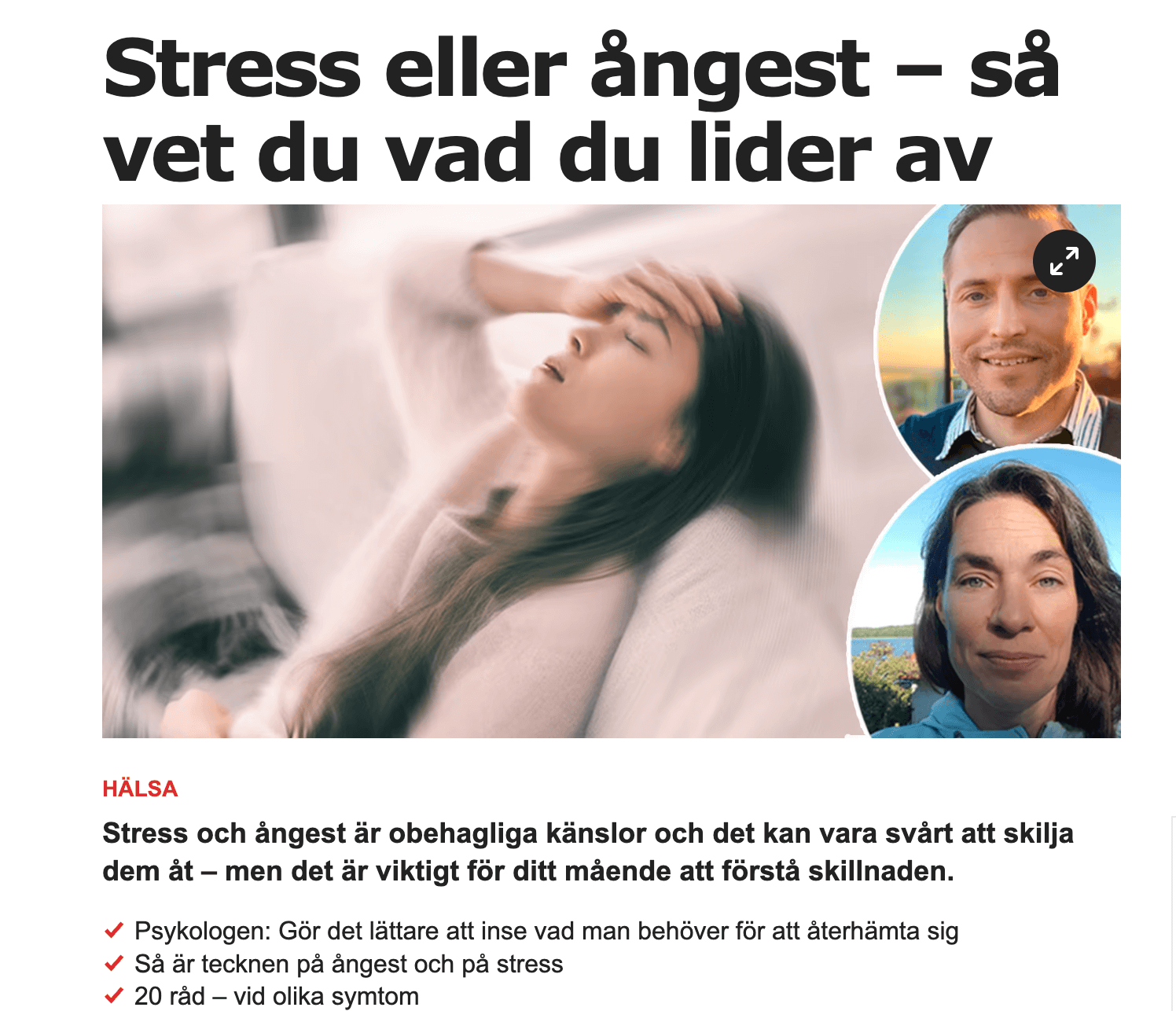Panic disorder
Get rid of your panic disorder and panic attacks now!
Being able to feel anxiety is necessary for us humans. Anxiety acts as a kind of alarm signal, which helps us avoid or escape from dangers. Most of us have therefore experienced anxiety and/or the occasional panic attack. Sometimes the feeling of anxiety can become so strong and present that it is difficult to function in everyday life.
What is panic disorder?
Panic syndrome, also called panic disorder, means that you have sudden and intense anxiety attacks with severe physical symptoms such as chest pains, dizziness and breathing difficulties. Panic disorder is a form of anxiety disorder characterized by unexpected and repeated attacks of intense fear or discomfort.
When does panic attack occur?
Panic disorder and its attacks can occur at any time, even when you are relaxed or asleep, and can be triggered by a variety of factors such as stress, physical exertion, social situations or other undefined factors.
Do you suspect panic disorder?
Book a free consultation with our psychologists and psychotherapists and we can help you put in the right treatment for your panic disorder. You can talk to a professional who guides you and can support you even with mild panic syndrome.
Interview about anxiety
Aftonbladet interviewed the Swedish psychologists about how to know what type of anxiety you suffer from and what you can do about it. Please read the entire article.
Panic disorder symptoms
Palpitations, chest pains, dizziness, difficulty breathing, upset stomach, and/or feelings of unreality are common symptoms of panic disorder. You can also get persistent pain in different parts of the body. Often you know why, but sometimes the feeling of discomfort and fear arises without a visible explanation. The attacks create a fear of losing control, going crazy, seriously ill or even dying. Many describe the attacks as the most frightening they have experienced, and it is common for people with panic syndrome to go to hospital emergency departments. In case of panic syndrome, one is affected by recurring panic attacks, strong concern about the consequences of them, and a fear of having further attacks. Disturbing depression is also common.
The symptoms of a panic attack may include:
Palpitation
Chest pain
Difficulty breathing
Sweating
Tremors
Dizziness
Nausea
Tingling or numbness in the hands or feet
Feelings of unreality or losing control of oneself or one's surroundings
Many people who suffer from panic disorder also experience a strong fear of experiencing further panic attacks which can lead to avoidance behaviors and social isolation.
Panic syndrome often develops into agoraphobia
People with panic disorder often develop agoraphobia, which means feeling uncomfortable around the places and situations associated with the attacks. One then begins to avoid these as much as possible, or endures them with great discomfort.
What is Agoraphobia?
Agoraphobia is often associated with a fear of squares or a phobia of public places.
Agoraphobia is anxiety over being in places or situations from which it may be difficult (or embarrassing) to escape or where it may be difficult to get help in the event of an unexpected or situationally conditioned panic attack or panic-like symptoms.
-Wikipedia on Agoraphobia
Stress increases panic syndrome
With increased stress, the risk of panic syndrome increases, although it can also come like a bolt from the blue. When the person has problems with stress, the treatment can also focus on preventing the increased risk of panic attacks through a treatment that also focuses on the balance between stress and recovery.
Panic syndrome causes you to misinterpret signals
People who have panic disorder often misinterpret their body signals. A heart palpitation that may come from stress or from having drunk a cup of coffee is misinterpreted and the person thinks they are having a heart attack. It is not uncommon for people to go to the emergency room and think it is a heart attack when it is actually panic disorder. The heart is examined and the person sometimes has to leave the hospital without having understood what the problem actually was.
Then it is often about panic disorder. Sometimes it's dizziness and the person has thoughts of disaster and thinks they're going to faint, lose control or go crazy. Others may hyperventilate and think they are suffocating or not getting enough air. What is common to people with panic disorder is the misinterpretation of bodily symptoms and thoughts of disaster.
Treatment for panic disorder
What then happens is that the person begins to avoid things in different ways. The person might stop drinking caffeine or stop running on the treadmill. The logic is: if I don't trigger my bodily symptoms, I can't have panic attacks. The problem with this is that the person then has a shortened life where they can no longer do as many activities. Another problem is that the person perpetuates his panic disorder because he learns that he was fine only because he avoided things that trigger the body. The notion that bodily symptoms can be dangerous thus lives on.
The person thus does not get the opportunity for new learning that shows that the catastrophic thoughts are not correct. It is important for the person with panic disorder to learn and understand that it is the brain that speculates and tries to understand the symptoms and then makes assumptions that are not true. The person who has these wrong assumptions takes these thoughts as truths which causes even more symptoms because the power of the thought is strong and affects the whole body. Then the person is in the vicious circle of the panic attack, where the physical symptoms give rise to thoughts of disaster, which give even more physical symptoms, etc.
How do Sveapsykologists treat panic disorder and panic syndrome?
Treatment with CBT and ACT is often used against panic disorder through, among other things, psychoeducation and different types of exposures: interoceptive, imaginary and in-vivo, so the person can get new experiences without their avoidance and safety behaviors. Where it sees that the symptoms are not dangerous, which means that the person has fewer panic attacks or stops having panic attacks altogether.


